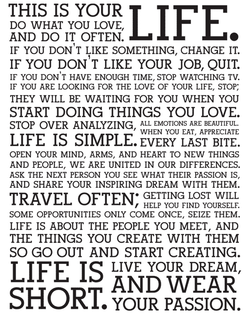
Often, it is difficult to ‘switch off’ at the end of the day. Our thoughts, sometimes seeming to come completely out of the blue, take on a life of their own as though we are actually living out each situation, effectively putting our minds and bodies through it all over again.
Being ‘present’ at this time is often very difficult as there are few things to distract us from our own distractions, leaving us with little control and the feeling that we are trapped with our runaway thoughts. Stopping this flow of thoughts and being able to relax into sleep requires firstly that we recognize that these thoughts – especially re-enactments of stressful situations – are not helpful. We either dig up events that are long gone in an effort to rewrite the script, or we look forward and worry about how things might turn out. In either case, we can do nothing at that moment, curled up in bed, to change what has or might happen. Realistically, the best thing we can do for ourselves is to commit to letting go of these thoughts and get a good night’s rest!
So, having decided that we want a bit of space from these thoughts, we can begin to work our mind out of that rush of activity and into a more sleep-conducive state of relaxation. Fortunately, there are many easy systems that we can use to calm our mind and take it away from harmful thoughts. Ultimately, you will learn to adjust whatever system you might use to work best for you, as most follow a simple pattern and can be altered easily.
Start by lying on your back in a comfortable position, letting your arms relax by your sides and your feet flop outwards. Take several deep, slow breaths to gather your focus, each time trying to relax your body with your exhalation. Once you are following your breath, visualize yourself breathing into a part of your body, slowly and evenly. As your exhale, consciously relax that part of your body. Feel it getting heavier and warmer, sinking into your bed. You can do this as many times as you like for each part, before moving on to the next. Start either at the top of your head or your feet, moving progressively down or up your body. As you begin, you may feel that your mind runs away – gently bring it back to your task and it will do so less and less as you gain your rhythm. Really focus on emptying each area with your exhalation and feel the heaviness it creates. As you approach an area, you may be surprised to find tension there – our body is constantly holding itself and it is a great relief to consciously let it go. Enjoy the feeling!
Releasing the tension in your body and focusing your attention does wonders in relieving the calamity in your mind, helping you get to sleep (and stay there). Try it – you will look forward to the warm, heavy feeling of relaxation all day tomorrow!
Happy sleeping!
Being ‘present’ at this time is often very difficult as there are few things to distract us from our own distractions, leaving us with little control and the feeling that we are trapped with our runaway thoughts. Stopping this flow of thoughts and being able to relax into sleep requires firstly that we recognize that these thoughts – especially re-enactments of stressful situations – are not helpful. We either dig up events that are long gone in an effort to rewrite the script, or we look forward and worry about how things might turn out. In either case, we can do nothing at that moment, curled up in bed, to change what has or might happen. Realistically, the best thing we can do for ourselves is to commit to letting go of these thoughts and get a good night’s rest!
So, having decided that we want a bit of space from these thoughts, we can begin to work our mind out of that rush of activity and into a more sleep-conducive state of relaxation. Fortunately, there are many easy systems that we can use to calm our mind and take it away from harmful thoughts. Ultimately, you will learn to adjust whatever system you might use to work best for you, as most follow a simple pattern and can be altered easily.
Start by lying on your back in a comfortable position, letting your arms relax by your sides and your feet flop outwards. Take several deep, slow breaths to gather your focus, each time trying to relax your body with your exhalation. Once you are following your breath, visualize yourself breathing into a part of your body, slowly and evenly. As your exhale, consciously relax that part of your body. Feel it getting heavier and warmer, sinking into your bed. You can do this as many times as you like for each part, before moving on to the next. Start either at the top of your head or your feet, moving progressively down or up your body. As you begin, you may feel that your mind runs away – gently bring it back to your task and it will do so less and less as you gain your rhythm. Really focus on emptying each area with your exhalation and feel the heaviness it creates. As you approach an area, you may be surprised to find tension there – our body is constantly holding itself and it is a great relief to consciously let it go. Enjoy the feeling!
Releasing the tension in your body and focusing your attention does wonders in relieving the calamity in your mind, helping you get to sleep (and stay there). Try it – you will look forward to the warm, heavy feeling of relaxation all day tomorrow!
Happy sleeping!

 RSS Feed
RSS Feed
